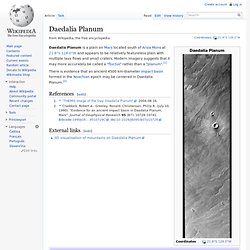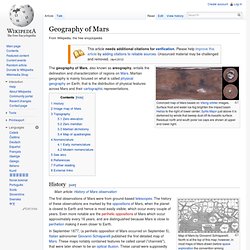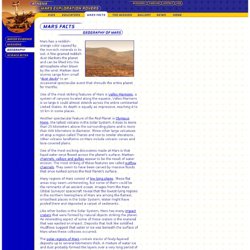

Daedalia Planum. Daedalia Planum is a plain on Mars located south of Arsia Mons at WikiMiniAtlas 21°48′S 128°00′W / 21.8°S 128.0°W / -21.8; -128.0 and appears to be relatively featureless plain with multiple lava flows and small craters.

Modern imagery suggests that it may more accurately be called a "fluctus" rather than a "planum".[1] There is evidence that an ancient 4500 km-diameter impact basin formed in the Noachian epoch may be centered in Daedalia Planum.[2] References[edit] External links[edit] Mars Rocks. Martian mini magnetosphere.
Maps of Mars. Gusev Crater. Mars topography. Geography of Mars. Colorized map of Mars based on Viking orbiter images.

Surface frost and water ice fog brighten the impact basin Hellas to the right of lower center; Syrtis Major just above it is darkened by winds that sweep dust off its basaltic surface. Residual north and south polar ice caps are shown at upper and lower right. The geography of Mars, also known as areography, entails the delineation and characterization of regions on Mars. Martian geography is mainly focused on what is called physical geography on Earth; that is the distribution of physical features across Mars and their cartographic representations. History[edit] Map of Mars by Giovanni Schiaparelli. In September 1877, (a perihelic opposition of Mars occurred on September 5), Italian astronomer Giovanni Schiaparelli published the first detailed map of Mars. Following these observations, it was a long held belief that Mars contained vast seas and vegetation.
Image map of Mars[edit] Topography[edit] North Polar region with icecap. Mars features. Mars Homestead Project Image Gallery - Hillside Settlement 1. The Mars Homestead Project - Arrive, Survive, & Thrive!™ Marspedia. Home. The Planetary Society. Mars Mobile. The Mars Society. Home - Mars One. Mission to Mars. Mars has a reddish-orange color caused by the iron-rich minerals in its soil.

A fine-grained reddish dust blankets the planet and can be lifted into the atmosphere when blown by the wind. Martian dust storms range from small " dust devils " to an occasional spectacular event that shrouds the entire planet for months. One of the most striking features of Mars is Valles Marineris , a system of canyons located along the equator. Valles Marineris is so large it could almost stretch across the entire continental United States. Its depth is equally as impressive, reaching 8 to 10 km in some places. Another spectacular feature of the Red Planet is Olympus Mons , the tallest volcano in the Solar System. One of the most exciting discoveries made at Mars is that liquid water once flowed across the planet's surface. SpaceRef - Mars Today. Mars TOP STORIES Beauty from Chaos on Mars Osuga Valles Beautiful streamlined islands and narrow gorges were carved by fast-flowing water pounding through a small, plateau region near the southeastern margin of the vast Vallis Marineris canyon system.

International Cooperation a Focus of From Here to Mars Senate Hearing If we're going to send Humans to Mars it should be an international effort where cooperation with the Russia and other partners is essential. Mars's Gusev Crater Once Held a Lake After All If desert mirages occur on Mars, "Lake Gusev" belongs among them. Mars. Mars One invites school pupils to design first mission. 10 December 2013Last updated at 18:06 ET By James Morgan Science reporter, BBC News Would you like to send an experiment to Mars?

The lander will carry modules designed by the public The first private spacecraft to land on Mars will carry experiments designed by students and school pupils, the firm behind the project has said. Mars One plans to send a robot lander similar to Nasa's Phoenix to test water purification and solar power modules. The Dutch-led firm hopes to establish a human settlement on Martian soil in 2025, by offering one-way tickets.
A satellite to relay live TV pictures, built by UK firm SSTL, will also be sent in the 2018 demonstration mission. The launch date has slipped two years later than originally announced, meaning the first colonists' arrival will also be delayed - 2025 is the new target. Continue reading the main story “Start Quote This is the next giant leap for mankind. End QuoteBas LansdorpMars One co-founder.